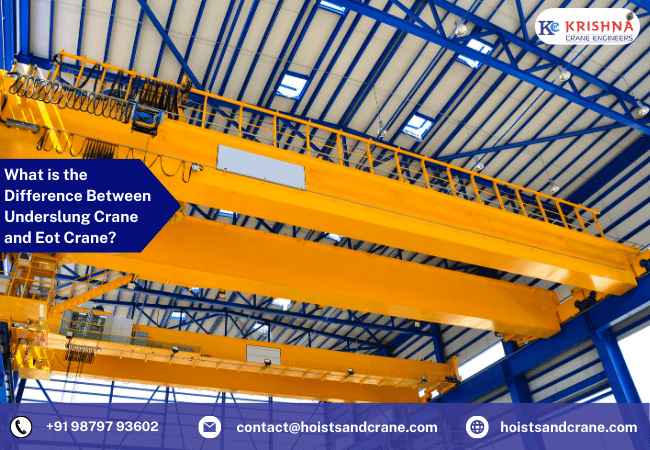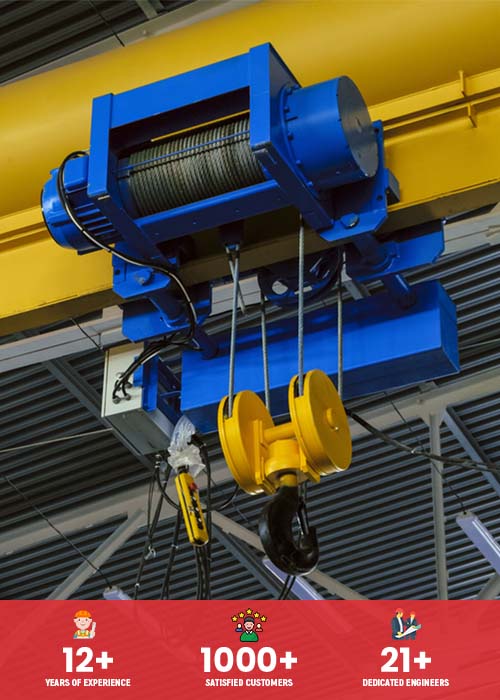What is the difference Between Underslung Crane and EOT Crane?
If you’re looking for a reliable and safe way to lift and move heavy equipment, then an underslung crane or an EOT (Electric Overhead Traveling) Crane might be the ideal solution for your business. But before investing in either of these two types of lifting cranes, it is important to understand their differences in features, design, capacity and maintenance requirements, and cost-effectiveness. In this blog post, we’ll explore how each type works and compare their respective advantages so that you can make an informed decision when choosing which will best suit your needs. An EOT crane manufacturer can help you get the best quality for your heavy equipment.
What is an underslung crane, and what are its benefits compared to other cranes?
An underslung crane is an overhead crane system that operates with its hoist and trolley suspended from an elevated runway beam. Crane manufacturer in Ahmedabad with quality cranes at affordable rates. This design allows operators to easily access cargo since the machinery isn’t in the way. Some of the benefits of underslung cranes compared to other types of cranes include the following:
- Increased maneuverability – Underslung cranes allow for greater flexibility and maneuverability than a traditional bridge or gantry cranes, making them ideal for confined spaces or operations on uneven ground where regular track-mounted systems may not be suitable.
- Reduced costs – The cost savings associated with underslung cranes can be substantial due to their low installation requirements compared to fixed overhead systems.
- Security – The lack of a fixed structure makes underslung cranes less vulnerable to damage or theft.
- Increased safety – Underslung cranes are typically considered safer than traditional overhead systems, as they’re designed to keep the lifting machinery below the hook, allowing operators to work more safely and efficiently.
- Reduced maintenance costs – Because they don’t require a runway beam or other structural support, underslung cranes often require less regular inspection and maintenance than bridge and gantry cranes.
Overall, underslung cranes provide greater maneuverability and cost savings than other crane systems due to their low installation requirements, increased safety features, and reduced maintenance costs. With these advantages, they are becoming increasingly popular in various industries.
EOT crane Manufacturer
EOT cranes are designed to handle various heavy-duty tasks with ease and precision. Developed by experienced engineers, these machines are built to exacting standards using top-of-the-line materials and components for maximum performance and durability. EOT crane manufacturers use advanced technologies and fabrication techniques to create the most reliable, durable, and efficient machines.
These cranes come in various sizes, allowing them to be used in various applications, from industrial manufacturing to construction sites. They can lift loads to hundreds of tons while providing excellent control over positioning accuracy. Many models come with safety features such as emergency stops, overload protection systems, redundancy power sources, and other accident prevention measures so that operations can be carried out safely and with peace of mind.
EOT crane manufacturers are also committed to providing excellent customer service and technical support. By offering prompt response to inquiries, parts availability, and repair services, they are dedicated to ensuring that their customers get the highest quality products at competitive prices. With helpful advice on how to use the machines correctly and maintenance tips for keeping them in top condition, these companies always strive to meet the needs of their customers.
How does an underslung crane work, and what are some key features/components?
An underslung crane is a lifting device that provides a way to move heavy objects in industrial and engineering settings safely. It consists of two main components: the crane itself and the hoist. The crane suspends from an overhead structure, such as a ceiling or building support beam, while the hoist supports the load from underneath.
The key features and components of an underslung crane include the following:
- A bridge—the bridge is part of the crane itself and is what allows for movement in both directions along its length. Its trolley travels along this bridge, allowing it to lift and lower heavy loads up or down with precision.
- A trolley—the trolley carries the motor-driven hoist, which is connected to a hook and chain or rope. The trolley can move back and forth along the bridge, allowing it to lift easily and lower heavy loads.
- A motor-driven hoist—this device is powered by an electric motor and is responsible for lifting and lowering the load via a hook or chain. It can be operated either manually or remotely through a control panel.
- Hooks/chains/ropes—these devices connect the hoist to the load, enabling them to be lifted from underneath. They come in various sizes and strengths depending on the load being handled.
- Control panels—the control panel allows for remote operation of the underslung crane, allowing for greater precision and accuracy when lifting and lowering heavy objects.
An underslung crane is a versatile and reliable piece of machinery used in many industrial and engineering settings. Its key components allow it to be used safely and efficiently, making it an ideal choice for easily moving large, bulky items. The hoist is particularly useful for lifting heavy items from below, meaning fewer risks are involved than if the load had to be lifted by hand. With its impressive combination of features and components, an underslung crane is a great tool for any business that needs to move large or heavy objects safely and precisely.
Who typically uses underslung cranes, and for what projects/purposes?
Underslung cranes are commonly used in a variety of industrial and commercial settings. They can be employed for many types of projects, including:
- Manufacturing and production facilities: In these contexts, underslung cranes are frequently used to move heavy parts or materials over short distances. They provide a maneuverable solution that is ideal for tight spaces.
- Warehousing operations: With their ability to lift heavy loads with relative ease, underslung cranes make it simpler to transport goods from one warehouse area to another without resorting to manual labor.
- Construction sites: Underslung cranes are often used in construction environments where they can hoist materials quickly and efficiently across substantial heights.
- Shipyards: Underslung cranes effectively move large materials and equipment across the shipyard floor with minimal effort. They are especially useful in smaller, more confined areas.
- Maintenance and repair facilities: Underslung cranes can be used to lift heavy objects or machines from one area of the facility to another during maintenance or repair operations. This allows technicians to access all machine parts easily without having to strain themselves physically.
Overall, underslung cranes offer a versatile solution well-suited for environments where maneuverability and stability are paramount considerations. With their ability to easily lift heavy loads across short distances and up to substantial heights, they provide a powerful and efficient way to move materials from one facility area to another quickly.
Key Differences Between Underslung Crane and EOT Crane
| Feature | EOT Crane | Underslung Crane |
| Mounting Type | Runs on top of girders | Suspended from the ceiling structure |
| Load Capacity | Up to 500 tons | Up to 10 tons |
| Best For | Heavy industries, power plants, steel factories | Warehouses, small workshops, assembly lines |
| Space Requirement | Requires a strong gantry structure | Can work in low-space environments |
| Cost | Higher due to heavy-duty structure | Lower due to lightweight design |
| Mobility | Moves in a straight line along rails | Can move along curved tracks |
| Installation Complexity | Requires strong support structure | Easier installation on existing beams |
📌 Pro Tip: If you have limited space, go for an Underslung Crane. If you need to lift heavy loads, an EOT Crane is the better choice!
Which One Should You Choose?
Go for an EOT Crane if:
✔ You need to lift heavy loads (above 10 tons).
✔ Your workspace has strong gantry support.
✔ You work in industries like steel, power plants, or shipbuilding.
Go for an Underslung Crane if:
✔ You need to maximize floor space in a small workshop or warehouse.
✔ Your load is below 10 tons.
✔ You require flexible movement along curved tracks.



